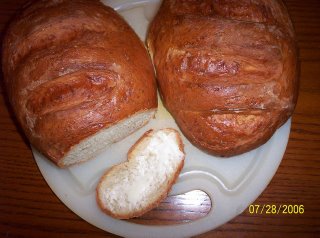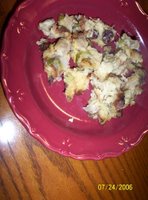Oatmeal Bread
 I just had an urge for bread - and this seemed like a good idea ... mostly because I had all this stuff on hand. So I better write the recipe down before I forget what I did - it was just sort of thrown together, but it came out amazingly good - but then bread almost always does.
I just had an urge for bread - and this seemed like a good idea ... mostly because I had all this stuff on hand. So I better write the recipe down before I forget what I did - it was just sort of thrown together, but it came out amazingly good - but then bread almost always does.0.5 cups water ( for yeast)
2.0 cups water or milk (even better)
1 pkg. yeast
1.5 cups oatmeal
4 tablespoons sugar
4 tablespoons butter
1 tablespoon salt
Flour
Proof yeast in 0.5 cups water with 1 tablespoon sugar.
Pour 2 cups hot water/milk over oatmeal, butter, sugar, salt and gluten.
When yeast is proofed and butter is melted, and yeast to oatmeal mix.
Mix and add flour, knead.
Place in buttered bowl, cover and let rise til doubled.
Punch down, form into loaves, slash tops, and let rise covered by towel.
Glaze with egg wash.
Bake at 400F for 10 minutes, then lower to 350F and bake 30 minutes longer.
Let the loaves cool on rack - covering loaves with a towel (so the crust won't get too hard).





